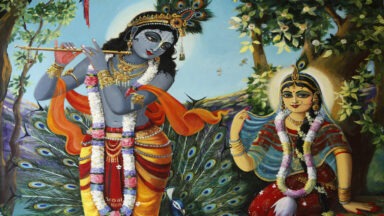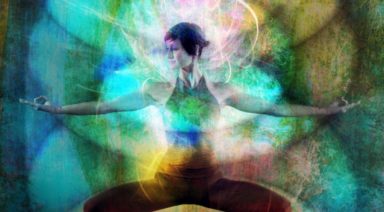Why Tantric Yoga Soul Gazing is Your New Favorite Practice

Communication occurs on many levels beyond talking and listening. Magic happens when the energy lines between people open. Soul gazing is a tantric technique that gives practitioners an altered state of consciousness by staring into another person’s eyes for ten minutes.
“Like iron filings being drawn to a powerful magnetic source, we experience ourselves as being ineluctably drawn closer to a shared feeling of union, relatedness and love. Where formerly we were two separate beings, we join together through the practice and become something that neither of us could quite be on our own.”
~ Johnson, “The Spiritual Practices of Rumi”
What is Tantra Yoga?
The Tantric practice aims to expand beyond perceived limitations of yogic philosophy and the asanas. When one meditates it is the space between thoughts where one begins to find a glimpse of inner peace. As yogis, we cultivate that space until the thoughts become less and less obtrusive, and the space between them becomes vast.
The exploration of the subtle energies within the body and their connection to the universe provide the opportunity to understand the purpose of life and the principles of union in new dimensions.
Try a Soul Gazing Excersize With a Partner
- Settle into a loose, cross-legged position (typically the larger person in Sukhasana first). Your partner then sits on your thighs and crosses their ankles behind your back.
- Touch your third eye centers (space between the eyebrows) as you both lengthen through your spines. Gaze lightly into each other’s eyes as you inhale and exhale through the nose.
- Place your palm on your partner’s heart center and have them place their palm over yours.
- Together, take five breaths, allowing a natural synchronicity of breath to emerge.
- Begin gazing into each other’s eyes. It may seem uncomfortable at first, but persist.
- Surrender to the intimate experience of both your and your partner’s heartbeat. Try this for 10 minutes.
Expand Your Capacity for Intimacy
If you’re practicing Tantra Yoga on your own or with a partner, you’re expanding your capacity for intimacy and union. With practice, we’re able to get up close and intimate with the beliefs and behaviors that hold us back from the intimacy we desire. In addition, Tantric techniques are provided to evolve beyond these barriers so that each and every one of us may thrive and prosper.
Vernal Equinox: Ritual Through Yoga

Over the course of each year, our playful planet performs an elliptic dance around the sun while simultaneously spinning about its own imperfect axis, which tilts roughly 23 degrees from vertical. Born of the primordial fire, the terms of this intricate cosmic relationship are responsible for all of the natural rhythms that inform our daily lives — from changing weather patterns to reliable zeitgebers that regulate our internal clocks.
When one tugs at a single thing in nature, he finds it attached to the rest of the world.
::John Muir
The Story of a Blue Sphere and a Fiery Mass
As Earth diligently revolves around the sun each year, there are four distinct sandhis, or junctures, where a clear seasonal shift occurs from our terrestrial perspective. The vernal equinox is one such juncture, marking the transition from winter to spring.
As we welcome the appearance of new life in nature, many of us remain blissfully unaware. We may neglect or even override the innate curiosity that seeks to understand how our cozy blue sphere and its fiery solar star orchestrate this magnificent show year after year. The truth is, when it comes to their relationship status, “it’s complicated.”
A Practical Approach to Visualization
Imagine yourself sitting in a camping chair with your feet warmed by the heat of a well-burning fire. Fortunately, you’re equipped with a warm scarf and hat to dull the chill you might otherwise experience as you recline back (at exactly 23.4°) to enjoy the stars. Now, without adjusting the direction your chair is facing, imagine yourself orbiting around the focal fire to the opposite side, giving the back of your head a chance to enjoy the warmth of the flame.
If your feet were the southern hemisphere and your head where the northern hemisphere, these two positions would represent the winter solstice (with more heat reaching the bottom half of your body) and the summer solstice (with more heat reaching the top half of your body) respectively.
To visualize the vernal equinox, imagine your chair was to revolve just a quarter of the way around this campfire circle. In this position, your body would be leaning neither toward nor away from the fire and the projected plane of your navel (the equator of your body) might pass directly through the center of the glow. Also, the light reaching one side of your body would match the darkness on the opposite side, much like the day and night which are of approximately equal length on the equinox.
Still confused? Don’t sweat it, simply allow yourself to enjoy the fruits of spring with a deep knowing that there are some wildly wonderful forces at play.
Emergence of the Exhale
Played out on a living, organic sphere, the seasons are guided by a unique planetary breath rhythm. The annual breath of the Earth, much like our own cyclical respiration, serves the purpose of bringing nutrients into the system in exchange for that which cannot be utilized. During the Vernal Equinox, our sleepy planet awakens from the depth of its winter inhalation and begins a 6-month out-breath.
Lean into the Light
Illustrated in the table above, the vernal equinox is a point of orbital balance marking the emergence of days that outlive nights as the axis of the planet bows once again, toward the sun. In direct response to increasingly available sunlight, a life that remained dormant in the barren winter months begins to awaken in receipt of new light. All of nature comes to life — hibernating creatures wake up with healthy appetites and germinating plants shed the shackles of their seeds.
“For a seed to achieve its greatest expression, it must come completely undone. The shell cracks, its insides come out and everything changes. To someone who doesn’t understand growth, it would look like complete destruction.” ::Cynthia Occelli
Subtle Body Spring: Melting the Inner Snow
As nature begins to melt the winter snow in spring, rivers and far-reaching tributaries swell with freshwater that sustains the natural environment as well as human communities. Mirroring the wisdom of the planet, now is the time to water any seeds of intention we may have planted at the beginning of the year and evaluate which future crops and creative projects we will irrigate with the melt of our inner snow.
Just as mountain rivers are swelling their waters, our bodies respond in much the same way at this time of year. This is nature’s way of melting the inner “snow” of the body.
::Shiva Rea, Tending the Heart Fire
Recalibrating Rhythm
Like a bear emerging from the deep sleep of hibernation, sometimes it can be difficult to recalibrate the body and mind for the vibrant spring rhythm. During the long period of seasonal darkness that precedes the vernal equinox, the body naturally increases melatonin production, a hormone that promotes the desire for sleep. This is the planet’s way of encouraging us to slow down and regenerate during fall and winter.
However, with the advent of smartphones and 24/7 connectivity, we override many of these environmental signals which can disrupt our natural circadian rhythms. This dissonance may leave energy levels, which were supposed to have been replenished during the winter, somewhat depleted when springtime arrives.
Fortunately, the daily increase in sunlight that occurs during this half of the year, has its own subtle body effects which include an increase in the mood-elevating hormone, serotonin as well as testosterone and estrogen.
While the shift in our internal chemistry generally increases energy and vitality, this period of hormonal recalibration puts a strain on the endocrine system which can leave us feeling a little tired as we meet the seasonal transition. To navigate the changing internal landscape, any effort to cleanse and detoxify the body can help alleviate energetic stagnation in preparation for the luminous spring ahead.
The Kappa Season
The predominant dosha during springtime is kappa, comprising earth and water. With heavy rains and warming temperatures, the elemental density and heaviness of kappa in late winter continues into spring. As we approach the equinox, it becomes necessary to balance these kappa qualities in order to alleviate winter-induced inertia and energetic malaise. The ideal rhythm for springtime is kappa-pacifying: meet the cool, oily, and heavy qualities of earth and water with the arid warmth and lightness of air and fire.
- Lighten Up. The vernal equinox welcomes a thorough spring cleaning, in our homes and in our hearts. Start by addressing any clutter that has accumulated during the winter and dispose of it in a meaningful way. In your home, this might be as simple as donating articles of clothing or re-purposing a piece of furniture. In your heart, you might tune into the presence of any heavy emotions, assimilate what you can learn from, and let the rest dissolve. Write in a journal to rid your subtle body of excess energetic weight and to create space for what is to come. Only once you have cleared any obstructions, can you begin a deep clean.
- Cleanse. Since kappa is able to sustain with or without food, enjoy a short fast or cleanse during the spring season using astringent fruit juices or warming, spiced kitchari. To stimulate the digestive fire before meals, try chewing on a small slice of fresh ginger. Shed layers of winter skin by dry-brushing before bathing and minimize the use of body oils. If you find yourself battling allergies with spring fever, consider cleansing the nasal passages with nasya, herb-infused oil, to facilitate the clear exchange of Prana. Alternatively, this can be done with warm salt water using a neti pot.
- Nourish. Concentrate on slow, mindful meal times so that your body experiences maximum satiety to avoid overeating or emotionally driven consumption which are symptoms of excess kappa. Favor light foods that are easy to digest with pungent, bitter, and astringent tastes. Foods like apples, pears, brussels sprouts, cabbage, and carrots for instance. Avoid heavy, oily foods with sweet, salty and sour tastes which increase kappa.
Invigorating Yoga Practices for the Spring Equinox
To bring balance to the gunas (attributes) of the kappa season, we emerge from the regenerative practice of the cold winter months and transition into the increased energy and mobility of spring. As we adapt to the seasonal rhythm, the most beneficial physical practices are those that enliven vira rasa. The term rasa can be used to define the intrinsic energetic quality or essence of being and vira is a word for hero. Vira rasa is the embodiment of potency and courage which are reinforced by an active, solar practice. This particular movement alchemy is appropriate for any time when we are experiencing a cycle of growth and renewal.
- Summon Your Strength — Enjoy arm balances and core cultivation as well as heating inversions to experiment with a new strength that has developed from the fortifying rest of winter.
- Clear Congestion — Relieve physical and emotional congestion by practicing dynamic postures with a vigorous pace before exploring strong, standing hip-openers, and activation. This can mobilize stagnant earth and water elements that may have accumulated here through winter.
- Burn Bright — Experience the ardent internal cleansing of heat-inducing pranayama such as kapalabhati, bhastrika and surya bhedana.
- Detoxify — Any process of purification requires a great heat. In the same way that steam can disinfect the surfaces in your home, internal heat and massage can assist the body’s natural metabolic processes which rid the system of toxins and purify the cells while reducing inflammation. Focus on postures that stimulate the circulatory, digestive and lymphatic systems like bound twists and activating backbends.
Spring Equinox Sequence: Moving Meditation for the Whole Body
Heart
Tap into your innermost virya, meaning vitality, enthusiasm, and effort, with focus and attention. Maintain an affirmative inner dialogue and embody the heart of a warrior. Either internally or aloud, invoke the mantra of supreme light with reverence to the sun, our absolute source of sustenance. Allow this to be a mantra of purification and release as you move toward internal balance.
OM HRIM HAMSA SO’HAM SWAHA
om: the primordial sound of the universe, the vibration of all creation, the guru
hrim: bija, seed sound for clarity and dispelling illusion, mantra for the cosmic light, the sun
hamsa so’ham: the balance of light and dark, sun and moon, Shiva and Shakti, the power of the breath for bringing vitality
swaha: let it be so, dedication to the light
*translations by David Frawley
Breath
During this stimulating practice, focus on powerful ujjayi breathing to circulate a steady supply of oxygen through the blood. Maintain a strong, audible breathing rhythm through the nostrils, releasing heat through the mouth on the exhale as needed. With this victorious yogic breath, internal body heat increases as does the circulation of Prana.
Body
This practice is a pilgrimage to Natarajasana that alchemizes twisting and backbends to open the channels of the spine and create space in the body. Beginning with an energizing kriya, we employ the breath to heat and polish the body from the inside out. What follows is a series of progressive twisting namaskars to energize and open before diving into standing backbends. The practice will close with deep-seated hip openers to alleviate emotional congestion before releasing into final relaxation.
To support your self-practice, please refer to the pose breakdown below with links to photos and alignment for each posture or enjoy the complete guided sequence video.




































